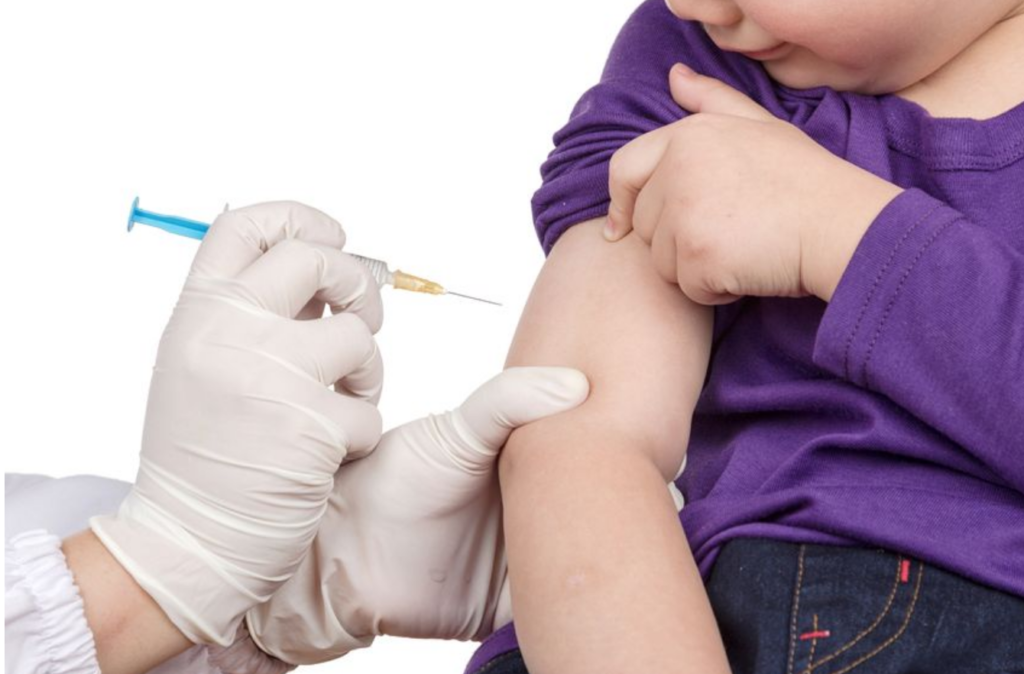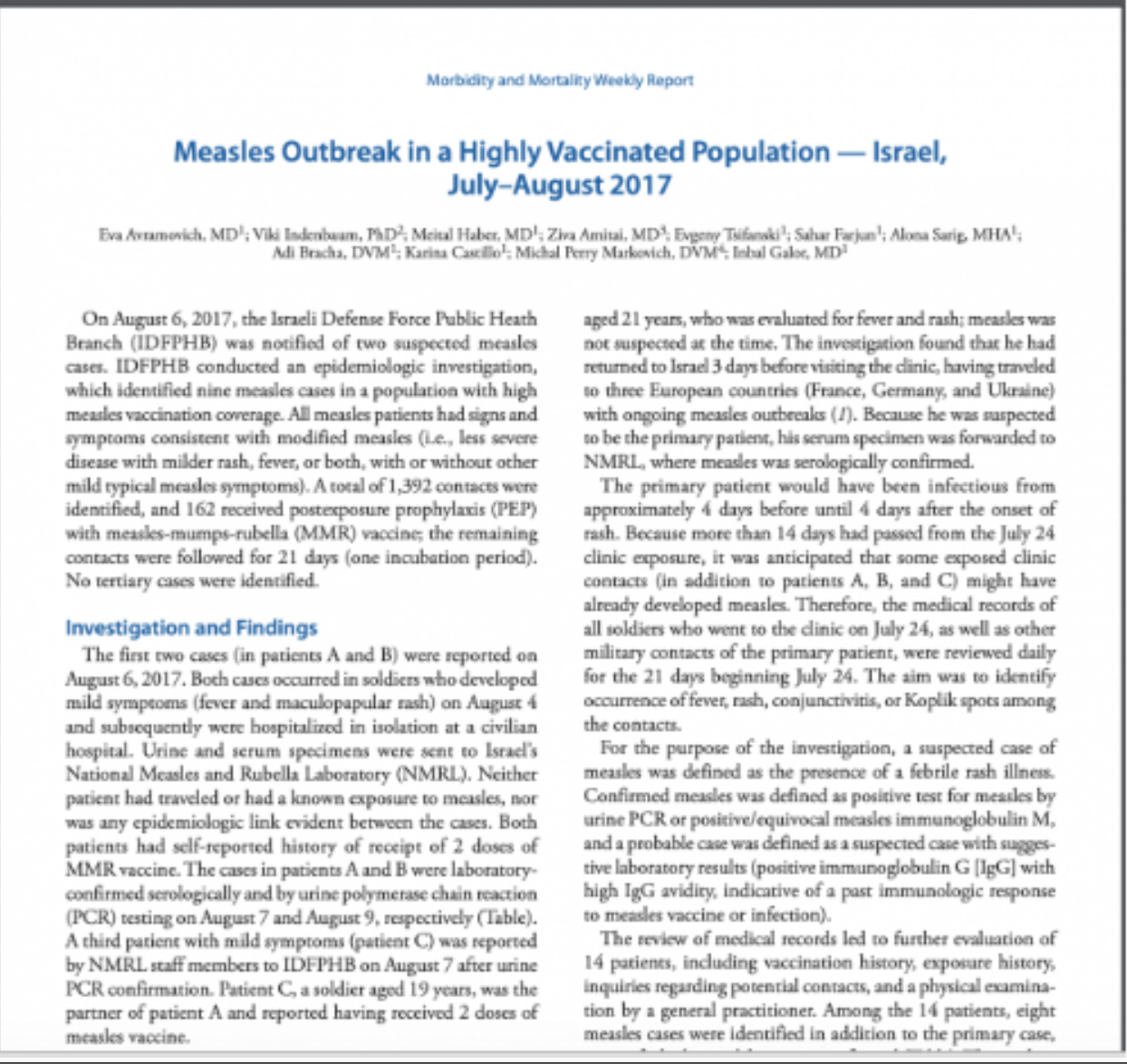
Source Article by Sayer Ji:
Measles Transmitted By The Vaccinated, Gov. Researchers Confirm
http://www.greenmedinfo.com/blog/measles-transmitted-vaccinated-gov-researchers-confirm
Research reveals that a vaccinated individual not only can become infected with measles, but can also spread it to others who are also vaccinated against it – doubly disproving that the administration of multiple doses of MMR vaccine is “97% effective,” as widely claimed.
One of the fundamental errors in thinking about measles vaccine effectiveness is that receipt of measles-mumps-rubella (MMR) vaccine equates to bona fide immunity against measles virus. Indeed, it is commonly claimed by health organizations like the CDC that receiving two doses of the MMR vaccine is “97 percent effective in preventing measles,” despite a voluminous body of contradictory evidence from epidemiology and clinical experience.
This erroneous thinking has led the public, media and government alike to attribute the origin of measles outbreaks, such as the one reported at Disney in 2015 (and which lead to the passing of SB277 that year, stripping vaccine exemptions for all but medical reasons in California), to the non-vaccinated, even though 18% of the measles cases occurred in those who had been vaccinated against it — hardly the vaccine’s two-dose claimed “97% effectiveness.” The vaccine’s obvious fallibility is also indicated by the fact that that the CDC now requires two doses.
MMR Vaccinated Can Still Spread Measles
Three years ago, a groundbreaking study published in the journal Clinical Infectious Diseases, whose authorship included scientists working for the Bureau of Immunization, New York City Department of Health and Mental Hygiene, and the National Center for Immunization and Respiratory Diseases, Centers for Disease Control and Prevention (CDC), Atlanta, GA, looked at evidence from the 2011 New York measles outbreak that individuals with prior evidence of measles vaccination and vaccine immunity were both capable of being infected with measles and infecting others with it (secondary transmission).
Titled, “Outbreak of Measles Among Persons With Prior Evidence of Immunity, New York City, 2011,” the groundbreaking study acknowledged that, “Measles may occur in vaccinated individuals, but secondary transmission from such individuals has not been documented.”
In order to find out if measles vaccine compliant individuals are capable of being infected and transmitting the infection to others, they evaluated suspected cases and contacts exposed during a 2011 measles outbreak in NYC. They focused on one patient who had received two doses of measles-containing vaccine and found that,
Of 88 contacts, four secondary cases were confirmed that had either two doses of measles-containing vaccine or a past positive measles IgG antibody. All cases had laboratory confirmation of measles infection, clinical symptoms consistent with measles, and high avidity IgG antibody characteristic of a secondary immune response.”
Their remarkable conclusion:
This is the first report of measles transmission from a twice vaccinated individual. The clinical presentation and laboratory data of the index were typical of measles in a naïve individual. Secondary cases had robust anamnestic antibody responses. No tertiary cases occurred despite numerous contacts. This outbreak underscores the need for thorough epidemiologic and laboratory investigation of suspected measles cases regardless of vaccination status.”
Did you follow that? A twice-vaccinated individual, from a NYC measles outbreak, was found to have transmitted measles to four of her contacts, two of which themselves had received two doses of MMR vaccine and had prior presumably protective measles IgG antibody results.
This phenomenon — the MMR vaccine compliant infecting other MMR vaccine compliant cases – has been ignored by health agencies and the media. This data corroborates the possibility that, during the Disney measles outbreak the previously vaccinated (any of the 18% known to have become infected) may have become infected or already were shedding measles from a vaccine and transmitted measles to both the vaccinated and the non-vaccinated.
Moreover, these CDC and NYC Bureau of Immunization scientists identified a ‘need’ for there to be “thorough epidemiologic and laboratory investigation of suspected measles cases regardless of vaccination status,” i.e. investigators must rule out vaccine failure and infection by fully infected individuals as contributing to measles outbreaks.
Instead, what’s happening now is that the moment a measles outbreak occurs, a reflexive ‘blame the victim’ attitude is assumed, and the media and/or health agencies report on the outbreak as if it has been proven the afflicted are under or non-vaccinated – often without sufficient evidence to support these claims. Clearly stakeholders in the vaccine/non-vaccine debate need to look at the situation through the lens of the evidence itself and not science by proclamation or pleas to authority.
Amazingly, the truth has been suppressed for decades. Twenty years ago, the MMR vaccine was found to infect virtually all of its recipients with measles. Scientists working at the CDC’s National Center for Infectious Diseases, funded by the WHO and the National Vaccine Program, discovered something truly disturbing about the MMR vaccine: it leads to detectable measles infection in the vast majority of those who receive it. The MMR vaccine’s manufacturer Merck’s own product insert, the MMR can cause measles inclusion body encephalitis (MIBE), a rare but potentially lethal form of brain infection with measles. Learn more by reading my article on the topic, “The Vaccinated Spreading Measles: WHO, Merck, CDC Documents Confirm.”
Stop Blaming A Failing Vaccine on Failure to Vaccinate
The moral of the story is that you can’t blame non-vaccinating parents for the morbidity and mortality of infectious diseases when vaccination does not result in immunity and does not keep those who are vaccinated from infecting others. In fact, outbreaks secondary to measles vaccine failure and shedding in up to 99% immunization compliant populations have happened for decades. Here are just a few examples reported in the medical literature:
-
1985, Texas, USA: According to an article published in the New England Journal of Medicine in 1987, “An outbreak of measles occurred among adolescents in Corpus Christi, Texas, in the spring of 1985, even though vaccination requirements for school attendance had been thoroughly enforced.” They concluded: “We conclude that outbreaks of measles can occur in secondary schools, even when more than 99 percent of the students have been vaccinated and more than 95 percent are immune.”1
-
1985, Montana, USA: According to an article published in the American Journal of Epidemiology titled, “A persistent outbreak of measles despite appropriate prevention and control measures,” an outbreak of 137 cases of measles occurred in Montana. School records indicated that 98.7% of students were appropriately vaccinated, leading the researchers to conclude: “This outbreak suggests that measles transmission may persist in some settings despite appropriate implementation of the current measles elimination strategy.”2
-
1988, Colorado, USA: According to an article published in the American Journal of Public Health in 1991, “early 1988 an outbreak of 84 measles cases occurred at a college in Colorado in which over 98 percent of students had documentation of adequate measles immunity … due to an immunization requirement in effect since 1986. They concluded: “…measles outbreaks can occur among highly vaccinated college populations.”3
-
1989, Quebec, Canada: According to an article published in the Canadian Journal of Public Health in 1991, a 1989 measles outbreak was “largely attributed to an incomplete vaccination coverage,” but following an extensive review the researchers concluded “Incomplete vaccination coverage is not a valid explanation for the Quebec City measles outbreak.4
-
1991-1992, Rio de Janeiro, Brazil: According to an article published in the journal Revista da Sociedade Brasileira de Medicina Tropical, in a measles outbreak from March 1991 to April 1992 in Rio de Janeiro, 76.4% of those suspected to be infected had received measles vaccine before their first birthday.5
-
1992, Cape Town, South Africa: According to an article published in the South African Medical Journal in 1994, “[In] August 1992 an outbreak occurred, with cases reported at many schools in children presumably immunised.” Immunization coverage for measles was found to be 91%, and vaccine efficacy found to be only 79%, leading them to conclude that primary and secondary vaccine failure was a possible explanation for the outbreak.6
The most recent example was released on the CDC’s website today in a report titled, “Measles Outbreak in a Highly Vaccinated Population — Israel, July–August 2017,” where they describe a patient zero who had received three doses of MMR. Not unsurprisingly the CDC does not draw the obvious conclusion that the MMR vaccine failed, rather, that they should consider the measles a possibility when they examine a patient with fever and a rash even when the patient is vaccinated.

CDC Source
These seven outbreaks are by no means exhaustive of the biomedical literature, but illustrate just how misled the general public is about the effectiveness of measles vaccines, and the CDC’s vaccination agenda in general. No amount of historical ignorance will erase the fact that vaccination does not equal immunization; antigenicity does not equal immunogenicity. Nor are the unintended, adverse effects of MMR and other vaccines in the CDC schedule accurately portrayed, precluding access to the medical ethical principle of informed consent.
This article was originally published at Greenmedinfo.com, by Founder Sayer Ji, posted here with permission. This article is copyrighted by GreenMedInfo LLC, 2018. You can sign up for their newsletter here.
REFERENCES


